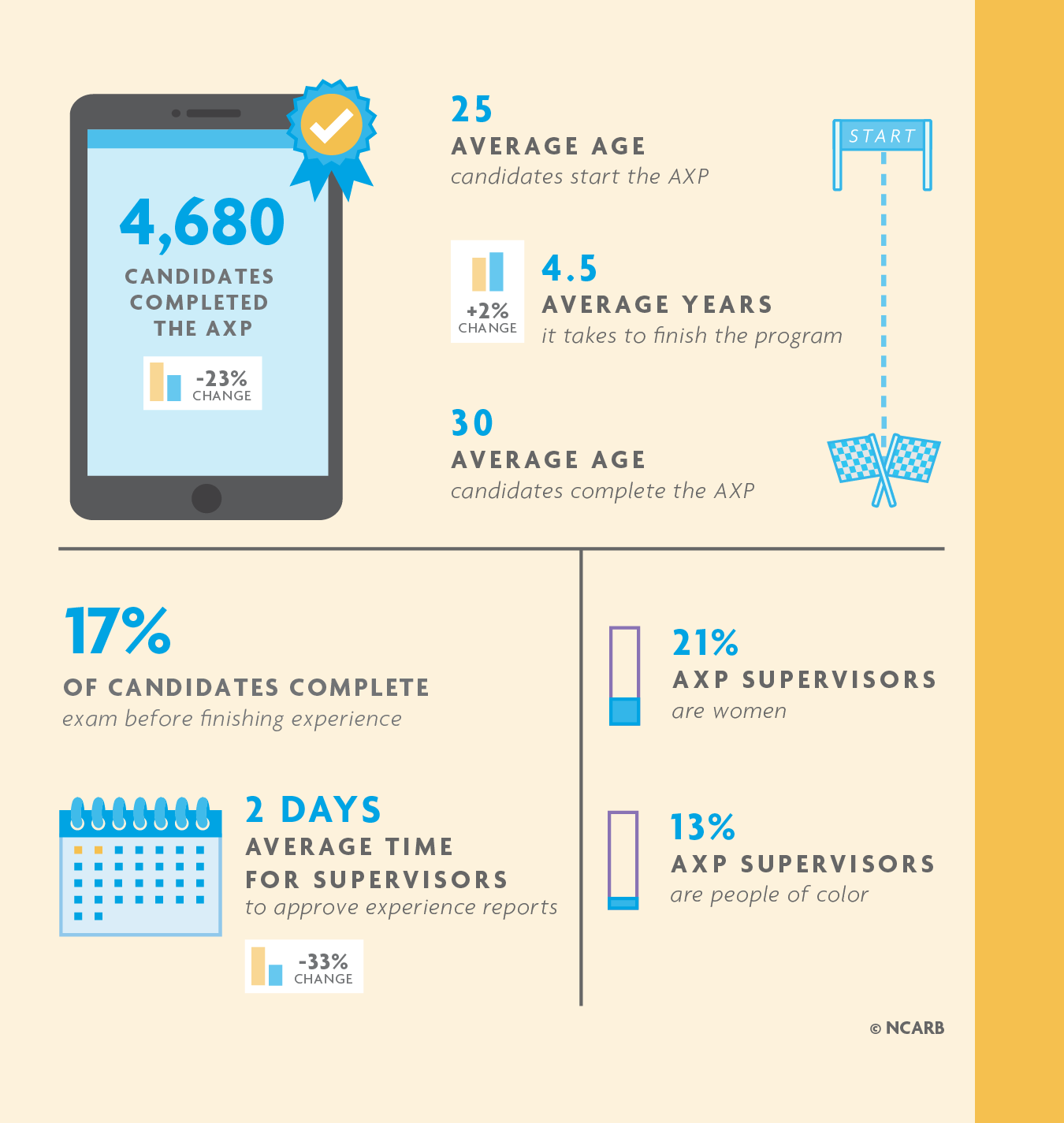Gaining real-world experience is a long-standing component of the licensure pathway for architects. Designed to guide candidates through earning and reporting the experience needed to practice architecture competently, NCARB’s Architectural Experience Program® (AXP®) is a required component of the licensure process in almost all U.S. jurisdictions.

Unsurprisingly, candidates in 2020 faced unprecedented hurdles that made it difficult to gain program experience due to a variety of challenges brought on by the COVID-19 pandemic.
The number of candidates who completed the AXP fell sharply to 4,680 total completions. This is 23 percent fewer AXP completions than in 2019 and well below the decade’s average of 5,354.
Nonetheless, 2020 data shows that candidates continue to earn and record experience earlier, often while in college—a trend NCARB expects to increase in the coming years. On average, candidates who finished the AXP in 2020 took 4.5 years to complete the program—one month longer than candidates in 2019.
In 2020, nearly 4,700 candidates completed NCARB’s experience program. This is 23 percent fewer candidates than in 2019. This sharp decline can likely be attributed to the uncertain economy throughout the COVID-19 pandemic, which may have resulted in fewer opportunities for candidates to gain firm experience.
Additionally, the overall decreasing trend seen over the last four years reflects a return toward normal rates, after a large number of candidates completed the program in 2016-2017 (leaving fewer candidates in the pool to complete the program in the following years).
Nearly 2,400 candidates automatically completed the program when experience areas were realigned in 2016. Additional program updates include removing elective hours (July 2015) and enabling candidates to earn 50 percent credit for experience more than eight months old (July 2014).
Note: Historical data can shift because licensure candidates can backdate experience up to five years. For example, if someone submitted a final experience report today containing experience earned in 2017, their AXP completion date would be 2017.
The average licensure candidate who completed the AXP in 2020 took 4.5 years, an increase of 2 percent—slightly more than one month—compared to 2019. The slight increases seen from 2017 to 2020 suggest that the time spent completing the experience requirement is stabilizing after the initial impact of several program updates made earlier in the previous decade.
The time it takes to complete the experience program has remained between 4.2 and 4.5 years since the removal of the program’s elective hours in 2015, which reduced the number of required hours by about a third. Two additional program updates—allowing candidates to report experience older than six months (2014) and realigning experience areas (2016)—contributed to the overall drop in the amount of time candidates take to complete the program.
Over the past decade, the amount of time it takes candidates to complete the experience program has shifted significantly, with greater proportions of candidates finishing experience requirements in less time. For example, the proportion of candidates finishing in under three years has more than quadrupled since 2011, now at 17 percent.
Candidates who take six or more years to complete the program still make up the largest proportion of individuals completing the AXP at 31 percent. However, this represents a 19 percent decrease from a decade ago, when 50 percent of candidates took six or more years to complete the experience program.
The average candidate beginning the AXP in 2020 was 24.8 years old—two months younger than the average candidate beginning the program in 2019. Licensure candidates who completed the experience program in 2020 were, on average, 29.7 years old when they finished, approximately one month younger than in 2019.
While neither age has shifted dramatically in recent years, NCARB’s ongoing outreach program to architecture students and the Integrated Path to Architectural Licensure (IPAL)—which allows students to complete the AXP and take the national licensing exam while in school—aim to encourage candidates to begin recording their professional experience sooner.
Of the candidates who completed the path to licensure in 2020, approximately 17 percent finished the Architect Registration Examination® (ARE®) before they completed their experience, the same proportion seen in 2019.
The gradual downward trend since 2016 of candidates completing the exam before completing the AXP is likely linked to the alignment of the AXP and ARE. Candidates appear to favor completing an experience area before taking the corresponding exam division.
On average, most experience reports in 2020 were reviewed and approved by a supervisor within just two days of the report’s submission. This reduction in approval time reflects improved technology and corresponding supervisor familiarity with the digital review and approval process.
Prior to 2009, experience was reported via mailed paper forms. In June 2010, NCARB implemented online experience reporting and began requiring candidates to report experience within six months of earning it for full credit. These changes contributed to the reduction in approval time from 2011-2013.
Of active AXP supervisors in 2020, nearly 21 percent were women—a 7 percent increase over the last decade. Men have made up between 79 and 80 percent of active AXP supervisors since 2018, with the proportion of male supervisors decreasing steadily over the last decade.
The proportion of AXP supervisors who were people of color did not change from 2019, remaining at around 13 percent. Following white supervisors, Asians were the next most represented at 7 percent of the total supervisor population.
Though 2020’s data shows slight increases in the representation of women among AXP supervisors across the past decade, the slow progress highlights the ongoing need to support equity and inclusion efforts for historically underrepresented groups within the architecture profession.